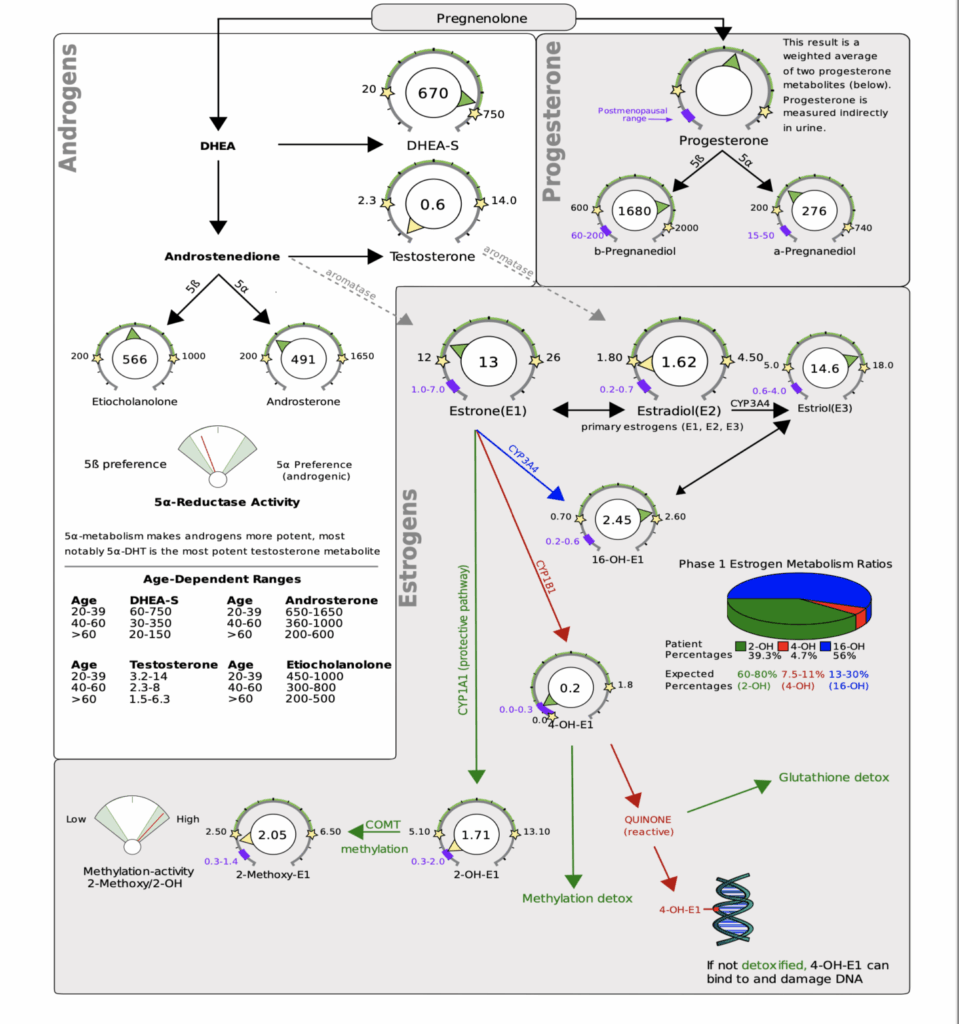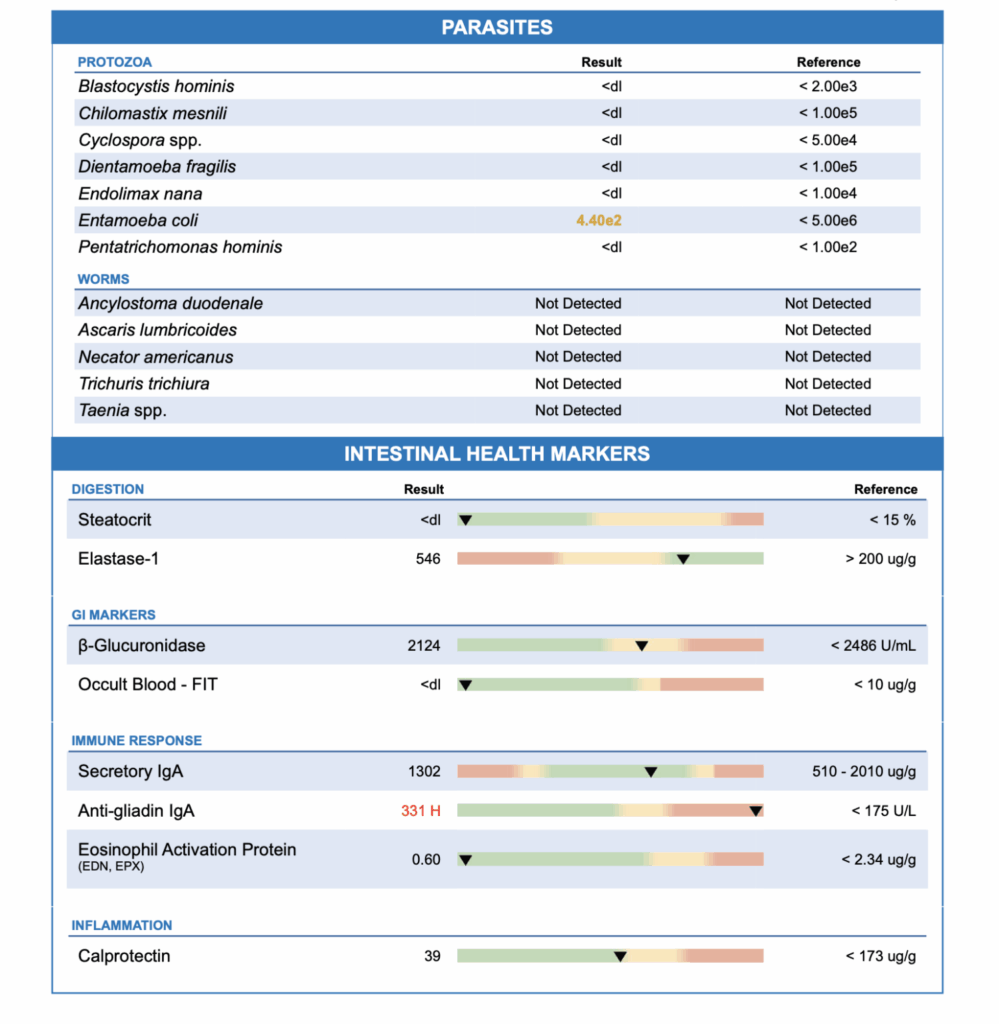Estrobolome: The Gut Microbiota and Estrogen Dominance
The gut microbiota and endometriosis: From pathogenesis to diagnosis and treatment: https://pmc.ncbi.nlm.nih.gov/articles/PMC9729346/
Estrogen dominance may lead to low progesterone levels – an imbalance between estrogen and progesterone. Progesterone is our “relaxing/chill pill” hormone. Balanced optimal levels means low levels of anxiety, calm mood, & better stress resilience due to interaction with GABA receptors.”
For estrogen dominance: Diindolylmethane (DIM) has shown to improve hormone health and metabolism by promoting the elimination of potentially harmful estrogen metabolites. (found in cruciferous vegetables)
Look at hormone and gut health since the estrobolome in the gut helps metabolizes estrogens (3).
Use DUTCH test to look at poor estrogen clearance, estrogen metabolism pathways (Phase I & II detox), estrogens (E1, E2, E3), estrogen metabolites (2-OH, 4-OH, 16-OH pathways), progesterone. Urine/saliva is more accurate than blood (serum) testing that is typically used in conventional medicine. Urine + saliva testing often give the clearest root-cause view.

DUTCH Test: Assessing Poor Estrogen Clearance, Estrogen Metabolism Pathways (Phase I & II detox), Estrogens (E1, E2, E3), Estrogen Metabolites (2-OH, 4-OH, 16-OH pathways), Progesterone
All of the data that is shown above is put into dials which can seem overwhelming at first but should be read as a pathway that tells the functional practitioner how your hormones are metabolizing. In the middle of the graph, you will see the three phases of estrogen metabolism or estrogen detoxification. Phase 1 metabolism is shown above as 2-OH-E1 (low) , 4-OH-E1 (in range), and 16-OH-E1 (high). Deficiency in certain nutrients will lead to insufficient phase 2 of the estrogen detox phase or insufficient methylation of the estrogen metabolites (Phase 2 Metabolism) as seen towards the bottom left of the page. (2-Methoxy-E1 + COMT enzyme)
If you would like to further evaluate Phase 3 of estrogen detoxification, looking at stool testing using the GI-MAP stool test is necessary to evaluate the gut microbiome. You would need to look specifically towards the intestinal health markers page at GI Markers: β-Glucuronidase. Your functional practitioner will recommend dietary changes as well as targeted supplementation to help modulate these three pathways. (Phase one, two, and three of estrogen detox)
GI-MAP: Assessing β-Glucuronidase & Estrogen Clearance
Use the GI-MAP to assess GI-MAP Stool Test: GI Markers:

β-Glucuronidase: elevated levels associated with gut dysbiosis (an imbalance in the gut microbiome), estrogen dominance, or poor detoxification.
High beta-glucuronidase levels can lead to estrogen being reabsorbed instead of eliminated → worsens estrogen dominance.
Support liver health: prioritize liver support since it helps detox and eliminate excess estrogen via the Phase 1 and Phase 2 liver detox pathways. This is to prevent estrogen recirculating.
Endo often linked with infertility.
Liver Health: Understanding the phases of detoxification and how to support them using food, lifestyle, and supplementation
Sluggish phase 1/2 liver detox impairs hormone clearance & contributes to estrogen dominance + PMS symptoms.
- Reduce exposure to xenoestrogens (BPA, phthalates, plastic use)
- Increase dietary fiber and lignans (e.g., flax, leafy greens)
- Eat 2 tbsp ground flax daily
- Consume cruciferous vegetables or take DIM
- Maintain healthy body fat percentage
- Support insulin sensitivity (movement, blood sugar regulation)
- Incorporate omega-3s (EPA/DHA)
- Use phytoestrogens (e.g., flax, sesame, soy in moderation)
- Avoid excessive alcohol intake
- Ensure daily bowel movements
- Support liver detox with B vitamins, magnesium, and glutathione
- Explore supplements that lower aromatase (e.g., green tea, citrus flavones)
Referrals
- OB/GYN

Read & Leave a Comment
Share